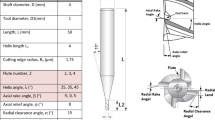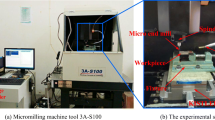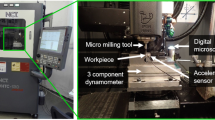Abstract
The progress of technologies associated with manufacturing has made it possible to obtain miniaturized components, which are showing increased use in many areas. The micromilling process stands out in obtaining these components for manufacturing surfaces with high dimensional precision and desirable finish, besides making the manufacture of microcomponents with complex geometry in various materials possible. Considering the importance of micromilling in obtaining the miniaturized components, it is fundamental to carry out investigations on this cutting process. To contribute to these investigations, this work aims to study the influence of the cutting length of the microtools in the micromilling of AISI 316L stainless steel. The influence of the cutting length was evaluated from the wear of the microtools, the formation of burrs, and the surface roughness. Also, Euler Bernoulli beam model was used to calculate the deflection of the microtools. Two cutting lengths were used, 0.8 mm and 0.6 mm. Through this deflection analysis, it was possible to observe that the shrank part consists of the most rigid part of the microtools independent of the cutting length, while the conical part of the shortest microtool and the cutting part of the longest microtool were the ones that most contributed to the lower stiffness of each tool. According to the experimental results, the wear of the microtools as a function of the machined length is similar to the wear of conventional tools; therefore, it was possible to obtain the Taylor equation under the analyzed cutting condition. Regarding the analysis of the influence of the cut length of the microtools, it was observed that the microtools with shorter cut length have greater rigidity, therefore less deflection, and longer life. However, for the shorter microtool to have a longer life, the cutting conditions used, rotation, and depth of cut must be stable conditions, to avoid the appearance of excessive vibrations that can reduce the life of the microtool, even if it presents greater rigidity. Regarding the roughness, it was observed that the deflection of the microtool did not influence the surface finish, which was affected by the cutting speed. It was found that the average roughness (Ra) varied from 0.1241 to 0.3206 μm for all the cutting conditions used, and the highest roughness was obtained at the highest cutting speed. The top burrs presented larger dimensions, and the burrs on the down milling side are larger than the up milling side. These results demonstrate the important contribution of this work to the understanding of micromachining processes.


























Similar content being viewed by others
References
Masuzawa T (2000) State of the art of micromachining. CIRP Ann Manuf Technol 49:473–488. https://doi.org/10.1016/S0007-8506(07)63451-9
Gherman L, Gleadall A, Bakker O, Ratchev S (2017) Manufacturing technology: micromachining. In: Fassi I, Shipley D (eds) Micro-manufacturing technologies and their applications. Springer Tracts in Mechanical Engineering. Springer, Cham, pp 97–127. https://doi.org/10.1007/978-3-319-39651-4_4
Rangel DA, Rojas FA, Arteaga NA (2011) Development of a CNC Micro-lathe for bone microimplants. Rev EIA 15:113–127
Jayanti S, Mavuleti K, Becker B, Erickson E, Wadell J, Marusich TD, Usui S, Marusich K (2012) Modeling of cutting forces and cycle times for micromachined components. Proc CIRP 1(1):138–143. https://doi.org/10.1016/j.procir.2012.04.023
Bakar MHA, Abdullah RIR, Ali MAM, Kasim MS, Sulaiman MA, Ahmad SSN, Raffi NFM (2014) Surface integrity of LM6 aluminum metal matrix composite when machined with high speed steel and uncoated carbide cutting tools. J Mech Eng Sci 6:854–862. https://doi.org/10.15282/jmes.6.2014.11.0081
Ng CK, Melkote SN, Rahman M, Kumar AS (2006) Experimental study of micro- and nano-scale cutting of aluminum 7075-T6. Int J Mach Tools Manuf 46(9):929–936. https://doi.org/10.1016/j.ijmachtools.2005.08.004
Câmara MA, Rubio JCC, Abrão AM, Davim JP (2012) State of the art on micromilling of materials, a review. J Mater Sci Technol 28(8):673–685. https://doi.org/10.1016/S1005-0302(12)60115-
Rodrigues AR, Jasinevicius RG (2017) Machining scale: workpiece grain size and surface integrity in micro end milling. In: Microfabrication and Precision Engineering 27-68. https://doi.org/10.1016/B978-0-85709-485-8.00002-4
Cheng K, Huo D (2013) Micro-Cutting – fundamentals and applications. Wiley, UK
Mian AJ, Driver N, Mativenga PT (2011) Identification of factors that dominate size effect in micro-machining. Int J Mach Tools Manuf 51(5):383–394. https://doi.org/10.1016/j.ijmachtools.2011.01.004
Liu K, Melkote SN (2007) Finite element analysis of the influence of tool edge radius on size effect in orthogonal micro-cutting process. Int J Mech Sci 49:650–660. https://doi.org/10.1016/j.ijmecsci.2006.09.012
Chae J, Park SS, Freiheit T (2006) Investigation of micro-cutting operations. Int J Mach Tools Manuf 46(3):313–332. https://doi.org/10.1016/j.ijmachtools.2005.05.015
Dornfeld D, Min S, Takeuchi Y (2006) Recent advances in mechanical micromachining. CIRP Ann Manuf Technol 55(2):745–768. https://doi.org/10.1016/j.cirp.2006.10.006
Sun Q, Cheng X, Liu Y, Yang X, Li Y (2017) Modeling and simulation for micromilling mechanisms. Precis Eng 174:402–407. https://doi.org/10.1016/j.proeng.2017.01.219
Rodríguez P, Labarga JE (2015) Tool deflection model for micromilling processes. Int J Adv Manuf Technol 76(1-4):199–207. https://doi.org/10.1007/s00170-014-5890-8
Singh KK, Kartik V, Singh R (2019) Stability modeling with dynamic run-out in high speed micromilling of Ti6Al4V. Int J Mech Sci 150:677–690. https://doi.org/10.1016/j.ijmecsci.2018.11.001
Villares Metals (2018) “Stainless steels” (in Portuguese). http://www.villaresmetals.com.br/villares/pt/Produtos/Acos-Inoxidaveis. Accessed 04 April 2018
Mijušković G, Krajnik P, Kopač J (2015) Analysis of tool deflection in micro milling of graphite electrodes. Int J Adv ManufTechnol 76(1-4):209–217. https://doi.org/10.1007/s00170-013-5536-2
Hibbeler HB (2010) “Strength of materials” (in Portuguese), 7th edn. Pearson Education do Brasil, São Paulo
Li P, Oosterling JAJ, Hoogstrate AM, Langen HH, Schmidt RM (2011) Design of microsquare end mills for hard milling applications. Int J Adv Manuf Technol 57(9-12):859–870. https://doi.org/10.1007/s00170-011-3330-6
Moges TM, Desai KA, Rao PVM (2018) Modeling of cutting force, tool deflection, and surface error in micro-milling operation. Int J Adv Manuf Technol 98(9-12):2865–2881
Machado AR, Coelho RT, Abrão AM, Da Silva MB (2011) “Metal cutting theory” (in Portuguese). Edgard Blucher, São Paulo
Aramcharoen A, Mativenga PT (2009) Size effect and tool geometry in micromilling of tool steel. Precis Eng 33(4):402–407. https://doi.org/10.1016/j.precisioneng.2008.11.002
Santos AG, Da Silva MB, Jackson MJ (2018) Tungsten carbide micro-tool wear when micro milling UNS S32205 duplex stainless steel. Wear 414:109–117. https://doi.org/10.1016/j.wear.2018.08.007
Hung WNP, Corliss M (2019) Micromachining of advanced materials, micromachining, IntechOpen. https://doi.org/10.5772/intechopen.89432
Alhadeff LL, Marshall MB, Curtis DT, Slatter T (2019) Protocol for tool wear measurement in micro-milling. Wear 420:54–67. https://doi.org/10.1016/j.wear.2018.11.018
Vieira GH, De Almeida SFM (2006) “Tool-free vibration analysis for high-speed machining” (in Portuguese). ITA – XII ENCITA. http://www.bibl.ita.br/xiiencita/mec_13.pdf
Smith S, Winfough WR, Halley J (1998) The effect of tool length on stable metal removal rate in high speed milling. CIRP Ann 47(1):307–310. https://doi.org/10.1016/S0007-8506(07)62839-X
Wang D, Wang X, Liu Z, Gao P, Ji Y, Löser M, Ihlenfeldt S (2018) Surface location error prediction and stability analysis of micro-milling with variation of tool overhang length. Int J Adv Manuf Technol 99(1-4):919–936. https://doi.org/10.1007/s00170-018-2446-3
Li Z, Wang Z, Shi X (2017) Fast prediction of chatter stability lobe diagram for milling process using frequency response function or modal parameters. Int J Adv Manuf Technol 89(9-12):2603–2612. https://doi.org/10.1007/s00170-016-9959-4
Lee K, Dornfeld DA (2002) An experimental study on burr formation in micro milling aluminium and copper. Transact NAMRI/SME 30(46):1–8
Piquard R, D'acunto A, Dudzinski D (2014) Study of burr formation and phase transformation during micro-milling of NiTi alloys. In: 11th International Conference on High Speed Machining. Czech Machine Tool Society
Silva LC, Da Silva MB (2019) Investigation of burr formation and tool wear in micromilling operation of duplex stainless steel. Precis Eng 60:178–188. https://doi.org/10.1016/j.precisioneng.2019.08.006
Kiswanto G, Zariatin DL, Ko TJ (2014) The effect of spindle speed, feed-rate and machining time to the surface roughness and burr formation of aluminum alloy 1100 in micro-milling operation. J Manuf Process 16(4):435–450. https://doi.org/10.1016/j.jmapro.2014.05.003
Chern GL, Wu YJE, Cheng JC, Yao JC (2007) Study on burr formation in micro-machining using micro-tools fabricated by micro-EDM. Precis Eng 31(2):122–129. https://doi.org/10.1016/j.precisioneng.2006.04.001
Zheng L, Chen W, Huo D (2019) Experimental investigation on burr formation in vibration-assisted micro-milling of Ti-6Al-4 V. Proc Inst Mech Eng C J Mech Eng Sci 233(12):4112–4119. https://doi.org/10.1177/0954406218792360
Filiz S, Conley CM, Wasserman MB, Ozdoganlar OB (2007) An experimental investigation of micromachinability of copper 101 using tungsten carbide micro-end-mills. Int J Mach Tools Manuf 47:1088–1100. https://doi.org/10.1016/j.ijmachtools.2006.09.024
Sorgato M, Bertolini R, Bruschi S (2020) On the correlation between surface quality and tool wear in micro–milling of pure copper. J Manuf Process 50:547–560. https://doi.org/10.1016/j.jmapro.2020.01.015
Funding
This study is funded by the Brazilian research funding agencies CNPq (National Council for Scientific and Technological Development), CAPES (Coordination for the Improvement of Higher Education Personnel), and FAPEMIG (Minas Gerais State Research Foundation).
Author information
Authors and Affiliations
Corresponding author
Additional information
Publisher’s note
Springer Nature remains neutral with regard to jurisdictional claims in published maps and institutional affiliations.
Rights and permissions
About this article
Cite this article
Gomes, M.C., da Silva, M.B. & Duarte, M.A.V. Experimental study of micromilling operation of stainless steel. Int J Adv Manuf Technol 111, 3123–3139 (2020). https://doi.org/10.1007/s00170-020-06232-7
Received:
Accepted:
Published:
Issue Date:
DOI: https://doi.org/10.1007/s00170-020-06232-7




